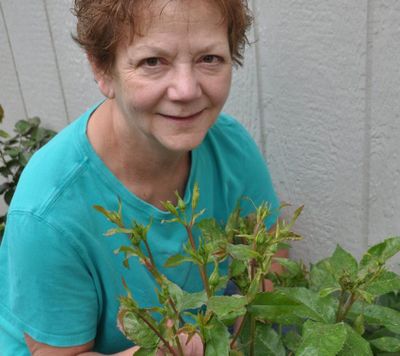Gardening: If aphids feasting on tender growth, get handle on them now

My friend Sylvia Passe sounded a little desperate during a recent online neighborhood conversation.
“You’ve got to write about aphids, they are all over my roses already,” she said.
I knew if Sylvia was having issues, other people were having them, too. Sure enough, the new growth and the emerging buds on her roses were hosting a healthy population of aphids.
Aphids are a problem this year because we’ve had enough rain and mild temperatures to create a banquet of lush tender growth for the aphids to feast on. Getting a handle on them now will cut down on issues later in the summer.
Adult aphids are tiny, pale green or tan, pear-shaped soft-bodied insects with three pairs of legs and long antennae. Some have wings but most do not. They produce several already pregnant nymphs a day. The nymphs mature in seven to eight days shedding their skins several times in the process. It’s easy to see the skins on the underside of a leaf.
Aphids feed by sucking juices from the plant. A few feeding on the plant may not cause much visible damage at first but as the population increases, the leaves and the flower buds become distorted and the plant vigor is reduced. Feeding aphids also exude a sticky sweet honeydew that attracts ants who feed on the honeydew. The ants will actually tend the aphids, so they continue to produce the sweet nectar.
Integrated pest management is the best way to control aphids. This process involves using progressive control methods while preserving other beneficial insects.
If you have just a few aphids, you can knock them off the plants with a hard stream of water. The force of the water won’t damage the leaves or buds and puts the aphids on the ground where they can’t survive. The arrival of hot weather will slow the population down because the aphids need moisture to survive.
If you have a small population, observe the plants watching for predator insects like lady beetles and their larvae, lacewings and soldier beetles. These predators are often in the garden already and will find the aphids over a short period of time. Do some research so you can identify these insects and their larvae. The aphid lion which is the lady beetle larvae is called that for obvious reasons, it devours aphids.
If, after a couple of weeks, you don’t see any predators, it might be time to bring out other control agents. Insecticidal soaps are the most commonly recommended control spray. The “soap” breaks down the protective coatings on the aphid’s skin, so they desiccate. Insecticidal soaps are different from homemade mixes of dish soap and water. Dish soap mixes contain compounds that can damage the foliage.
Lightweight horticultural oils or neem oil can also be applied to the insects. These oils plug the aphids breathing spiracles, so they suffocate.
The advantage of the soaps and oils is that they don’t leave a toxic residue that can kill other beneficial insects.